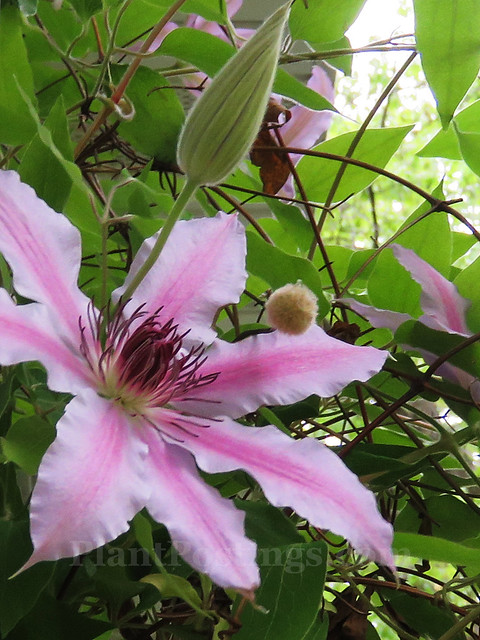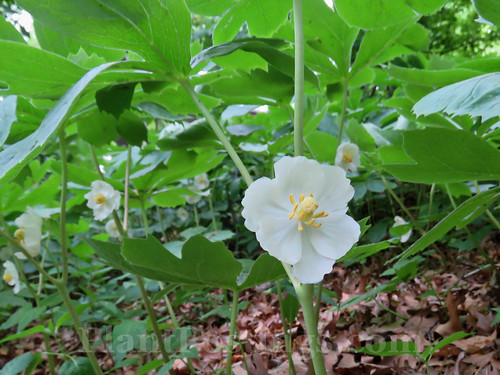
It's a busy time in the garden lately, with frosts and freezes behind us, and planting and adjustments in full swing. In the midst of the busyness, I've been encouraging myself to pause just a bit to contemplate the garden and nature. I've been thinking about the beauty of plants that climb and vine and drape. They inspire art, design, and many other aspects of life.
One example (above) is the draping beauty of Bleeding Heart (Lamprocapnos spectabilis), with its nodding, hanging blooms favored by hummingbirds.

The vining activity of Thicket Creeper (Parthenocissus inserta) helps to compete with nonnative invasives, filling crevices of planting beds at the base of shrubs and tall plants. And its foliage is beautiful from spring through October.

Clematis 'Nelly Moser' is another plant that was here when we moved in; I've maintained and encouraged it over the years. The flowers this time of year are exquisite, and its vines climb two trellises at the corners of our sunroom.

During a recent hike, we noticed this gigantic Riverbank Grape vine (Vitis riparia), forming an "S" around a tree. This is not a cultivated grouping, but it is beautiful in its natural form.

The Climbing Prairie Rose (Rosa setigera) I planted as a small seedling several years ago is now up and over its arbor, and draping down the other side. Soon it will be covered in blooms!

Fuchsias of various species and varieties have been mainstays in my shady garden over the decades. This one, 'Dark Eyes,' has trailing buds and blooms that grace hanging baskets along the front porch. It's another favorite of hummingbirds.

While I've transplanted some Ostrich Ferns (Matteuccia struthiopteris), I've never had to purchase them. They occur naturally in our back garden and provide draping beauty to frame the central planting bed.

Another plant that occurs naturally here: Mayapples (Podophyllum peltatum). I find the arching habit of the foliage over the blooms and later the fruit to be magical and artful. My previous post shows our hillside from above, covered in Mayapple plants.


The vining activity of Thicket Creeper (Parthenocissus inserta) helps to compete with nonnative invasives, filling crevices of planting beds at the base of shrubs and tall plants. And its foliage is beautiful from spring through October.

Clematis 'Nelly Moser' is another plant that was here when we moved in; I've maintained and encouraged it over the years. The flowers this time of year are exquisite, and its vines climb two trellises at the corners of our sunroom.

During a recent hike, we noticed this gigantic Riverbank Grape vine (Vitis riparia), forming an "S" around a tree. This is not a cultivated grouping, but it is beautiful in its natural form.

The Climbing Prairie Rose (Rosa setigera) I planted as a small seedling several years ago is now up and over its arbor, and draping down the other side. Soon it will be covered in blooms!

Fuchsias of various species and varieties have been mainstays in my shady garden over the decades. This one, 'Dark Eyes,' has trailing buds and blooms that grace hanging baskets along the front porch. It's another favorite of hummingbirds.

While I've transplanted some Ostrich Ferns (Matteuccia struthiopteris), I've never had to purchase them. They occur naturally in our back garden and provide draping beauty to frame the central planting bed.

Another plant that occurs naturally here: Mayapples (Podophyllum peltatum). I find the arching habit of the foliage over the blooms and later the fruit to be magical and artful. My previous post shows our hillside from above, covered in Mayapple plants.

This Shamrock plant (Oxalis vulcanicola 'Zinfandel') has been a potted mainstay in the garden during summer, and in the sunroom in winter. Its burgundy, draping stems and foliage, and yellow flowers, add color to our shady back lot.
These are just a few examples of the artful vining, draping, and trailing habits of garden plants. They inspire creativity, and support pollinators and people. Here's to a great growing season ahead!
It's good that you mention ostrich feather ferns. I had noted them on an old wish list and it makes me think again. Thanks!
ReplyDelete(I just saw that they are ok in zone 6 which would be perfectly fine for my garden, since I'm between 8A and 8B)
Yes, the Ostrich Ferns are native here, and I'm zone 5 (U.S.). So they should be fine in your garden. You likely know this, but there are several different species of Ostrich Ferns common and available in various locations. Good luck, and keep me posted. :)
DeleteIt’s amazing how that vine is snaking its way around the tree and you’re spot-on when you say that it is beautiful in its natural form. Your Prairie Rose has really travelled - I hope you’ll post it again when the flowers arrive, I can imagine how impressive it will look on your arch. The ferns are glorious!
ReplyDeleteHi Catherine: Yes, it's amazing how thick the Grape vines can be. It's thicker than many of the branches on the tree. I'm so happy with the Prairie Rose, so I'm sure I'll be posting about it again. :)
DeleteGood to see the photo of your Ostrich Fern, I have it here and it spreads nicely but is easily controlled. Lovely photo of your Dicentra, gorgeous!
ReplyDeleteYes, I've had the same experience over the years with the Ostrich Ferns. I just have to keep them in check, but it's not too hard. They really give the garden character. :)
DeleteSorry, didn't mean to be ananymous, like Nelly moser too!
ReplyDeleteNo problem. Thanks for letting me know it was you. :)
DeleteHi Beth, your photos are absolutely gorgeous! Thank you so much for sharing.
ReplyDeleteThank you, Linda. The plants provide so much inspiration and joy. :)
DeleteYour garden is lovely, Beth. I've only succeeded in growing one Clematis here and I couldn't grow bleeding hearts if my life depended upon it. Only a few ferns, all less attractive than your ostrich fern, can handle conditions here.
ReplyDeleteThank you, Kris. :) During the spring and during a summer and autumn with enough precipitation, it's a relatively lush place here. The Ferns and Clematises are usually OK, but they sometimes brown up during a dry summer. Bleeding Hearts work well in the hanging baskets where it's easy to water them regularly.
DeleteIt all looks so refreshing Beth. I can just breath in deep and smell the love of green. :-)
ReplyDeleteIt is all beautiful.
Carla
Hi Carla: Thank you. It's been a weird back-and-forth spring...more than usual...but the plants seem happy. And the vining and draping forms are fascinating. Have a great week!
DeleteVery nice set of photos, Beth. That 'Nelly Moser' really is stunning! It must be something to see the full vine. And the grape vine curved around the tree, I've seen similar in hikes and it's always a lovely pairing of stalwart tree and limber vine. Have fun in your garden! Tina
ReplyDeleteHi Tina: Thank you. I do love the 'Nelly Moser' Clematis. It was here when we moved in, but I love the color and form, and it reminds me of my grandma, because "Nellie" (spelled differently, but oh well) was her name.
DeleteThe Vitis is spectacular! Just got home from a long trip, to flowers in bloom and leaves on (some) trees, so great to see
ReplyDeleteYay! I'm glad your garden is awake now, too. Such a great time of year, isn't it?
DeleteLovely tour! Happy Spring! If only I could grow fuchsias and bleeding hearts. Amelia
ReplyDeleteHi Amelia: The Fuchsias and Bleeding Hearts are mainstays here, partly because of the shade. They certainly add color and interest. :)
DeleteBeautiful photos, Nelly Moser is especially gorgeous. Your garden is looking so lush and green.
ReplyDeleteThanks. :) 'Nelly Moser' is definitely a favorite in mid- to late spring. And she's having a good year, along with many of the other plants, because the temps have been cool...but no frost or freezes since mid-April.
DeleteYour growing season looks pretty good already!
ReplyDeleteThose native ferns are spectacular. As is of course the Lilac.
Hope to see the Prairie Rose flowering in a future post!